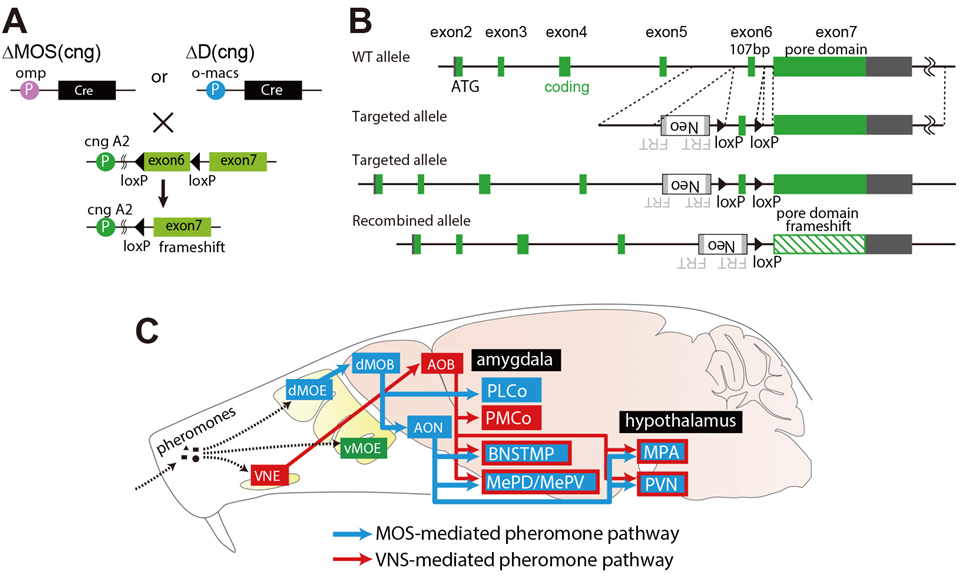 |
March 2017 Mouse of the Month |
Identifying pheromone circuits in mice
B6.129-Cnga2<tm1Kob> (RBRC09260)Courtesy of Tomohiko Matsuo, Ph.D. and Reiko Kobayakawa, Ph.D. A. Strategy for generating ΔMOS(cng) mice, ΔD(dta) mice, and ΔD(cng) mice. B. Schematic diagram for generating Cnga2 Conditional knockout mice. Following Cre recombination, exon 6 is deleted resulting in a frame-shift of exon 7, which contains the channel pore and cAMP binding domains. C. Model of MOS- (blue) and VNS- (red) mediated pheromone pathways in mice. The areas receiving input from both subsystems are colored in both red and blue. O-MACScre/+mice were used as controls. MOS, main olfactory system; VNS, vomeronasal system. |
|
Main olfactory system (MOS) and vomeronasal system (VNS) are the two major olfactory subsystems in most of the mammals. Conventional depletion of main olfactory epithelium (MOE)-specific proteins, such as cyclic nucleotide-gated cation channels, results in impaired sexual discrimination in mice [1]. However, we cannot dissociate MOS functions from those of VNS in these KO mice as the MOE-specific proteins are expressed in both olfactory sensory neurons (OSNs) and the brain. Kobayakawa and colleagues generated Cnga2 conditional knockout mouse strain to eliminate Cnga2 in mature OSNs using OMP-Cre mice (RBRC02138) or in OSNs in the dorsal zone using O-MACS-Cre mice (RBRC06346) [2]. Their novel approach revealed that social behaviors are regulated by the MOS in a VNS-independent manner, shedding light on pheromone signaling in mammals without VNS like human. |
| Depositor | : | Reiko Kobayakawa, Ph.D. Department of Functional Neuroscience Osaka Bioscience Institute |
|
| Strain name | : | B6.129-Cnga2<tm1Kob> | |
| RBRC No. | : | RBRC09260 | |
| References | : | [1] | Mandiyan VS, Coats JK, Shah NM. Deficits in sexual and aggressive behaviors in Cnga2 mutant mice. Nat Neurosci.; 8(12):1660-2, 2005. |
| [2] | Matsuo T, Hattori T, Asaba A, Inoue N, Kanomata N, Kikusui T, Kobayakawa R, Kobayakawa K. Genetic dissection of pheromone processing reveals main olfactory system-mediated social behaviors in mice. Proc Natl Acad Sci U S A.;112(3):E311-20, 2015. | ||
| March 2017 Contact: Shinya Ayabe, Ph.D. Experimental Animal Division, RIKEN BioResource Center All materials contained on this site may not be reproduced, distributed, displayed, published or broadcast without the prior permission of the owner of that content. |





